The MOTO BOARD - and How Motos are Built
The MOTO BOARD
|
So, you are ready for great racing and the motos have just been posted...and you wage the million dollar question...WHAT DOES IT ALL MEAN?? Hopefully this page will help you answer that question....we have posted 5 examples of the basic types of motos in which you may be placed. A few important things to remember:
|
|
|
Here are 5 moto sheet examples of typical transfer combinations (Click on the image for a larger printable image): |
|
| TOTAL POINTS: 3 riders, no main event, racers will race in all 3 motos with their 3rd moto held during the main events. | 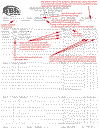 |
| Qualify 2-2-3: 8 riders, 1 group, once a rider qualifies for the main, he/she does not race again until the main. | 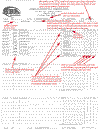 |
| Qualify 1-1-Combine 4: 9 riders, 2 groups, once a rider qualifies for the main, he/she does not race again until the main. | 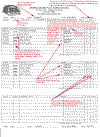 |
| Qualify 1-1-2: 10 riders, 2 groups, once a rider qualifies for the main, he/she does not race again until the main. | 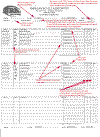 |
| Qualify 1-1-2 to Semi and Qualify 4-4 to Main: 15 riders, 3 groups, once a rider qualifies for the semi-main, he/she does not race again until the semi-main; from the semi main, the riders must then qualify for the main. | 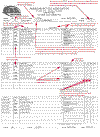 |
This page was updated 1/16/2014
How Motos are Built
Class Creation Procedures
The following describes class requirements as well as explains the procedures for combining classes when necessary.
A. Girls (Novice, Girl)
1. All new female members have the option to be classified as a Novice and will compete in the Novice class (male and female) at all events. Females will follow the move-up procedures as outlined in Section IV, B. Boys,pertaining to Novice class formation.
2. Any female Novice that voluntarily signs up and competes in a Girl class will be required to race in the Girls class at all events.
3. A Girl rider may voluntarily sign-up and compete in a Expert class at a local single-point race.
4. Classes will be created according to the following process:
• The move-up procedure will always begin with the class of the youngest age available. Once a class is formed, the process picks up the next available class (youngest age dictating the order) and proceeds from there.
• Class creation will start at 5 & Under Girls looking to form a legal class (defined as three or more riders)
• Girl riders will only check up through the Girl spectrum within a three age group barrier. If a rider is unable to move into a legal class, then she will be moved into the Intermediate class of her respective age, 12 - 9 = 3 (Ex: a 9-year-old Girl can move only as high as 12 Girl).
• Any rider in the 5 & Under class will be determined a 5 year old regardless of actual age and any rider in the 31 & over class will be determined a 31 year old regardless of actual age for the purpose of class creation.
• If the oldest Girl rider(s) of the day cannot form a legal class, that oldest rider(s) may then move down no more than three age groups checking for a legal class. (The three age group barrier cannot be compromised.) There can be occasions, when the oldest Girl rider moves down, another rider of different age may follow that move down to the next legal class. (Ex 1: Three 17 Girls (a legal class), one 21 Girl and one 26 Girl (oldest rider of the day). The 21 Girl checks 26 Girl, which contains a single rider, looking for a legal class. She would become a 28 Girl for the purpose of class creation. Both riders would then check down to 17-20 Girls and form a class of five riders.)
(Ex 2: Two 8 Girls, one 11 Girl, and one 12 Girl. The two 8 Girls would check 11 Girl to form a legal class. The 12 Girl would check to 15-16 Girl but no legal class is formed. She would then check down a maximum of 3 age groups looking for a class. It would appear that a combination at the 11 Girls class is legal but as there are 8-year-old riders in the class, the 3-year age barrier is violated. The oldest Girl would be required to move into the boys Inter class of her respective age. )
• If a Girl rider cannot move into a legal class, then they will move into the boys’ Intermediate class of their respective age. (Any riders in a combined Girl age group will move to the Boys Inter class of their ACTUAL age.)
5. When a class is formed, that class is labeled with the title of the group in which it was formed. (Ex: The 13 Girl class moves up to the 14 Girls forming a legal class, the class will be labeled as 14 Girls.)
B. Boys (Novice, Intermediate, Expert)
1. Classes will be created according to the following process:
• The move-up procedure will always begin with the young-est age and lowest proficiency available.Once a class is formed, the process picks up the next available group (youngest age dictating the order) and proceeds from there.
• Class creation will start at 5 & Under Boy.
• In an effort to facilitate Novice class formation, Novice groups may check as many as two (2) Novice age groups above their own, in an effort to form a legal class (defined as three or more riders) before attempting to check the Intermediate and Expert classes.
• If a legal class cannot be formed, the Novice will return to their respective class. (Ex 1: 6 Novice will check 7 Novice class looking to create a legal class. If that minimum were not met, then the 6 Novice would check 8 Novice class looking for a legal class.) (Ex 2: If there is a 7 Novice rider available, both the 6 & 7 Novice riders would combine, checking the 8 Novice class looking for a legal class. If a legal class cannot be formed, the 6 & 7 Novice riders will return to their respective classes.)
• A Novices following move will be to the next proficiency of the same age. (Ex: The 6 Novice rider will check the 6 Inter group looking to form a legal class.) If no legal class is formed, that rider will remain with this Inter group for move up purposes.
• An Intermediate class (in this case with the Novice rider attached) will check the next age group of the same proficiency. (Ex: The 6 Inter group checks the 7 Inter group looking to make a legal class.) If no legal class is formed, the Inter group will return to its home group (6 Inter).
• An Intermediate class’ subsequent check is the Expert group of the same age, looking to form a legal class of 3 riders. (Ex: The 6 Inter group will check the 6 Expert group.) If no legal class is formed, the Inter group will remain with the Expert group for move up purposes.
• An Expert class will check the next older age group of the same classification looking to form a legal class. (Ex: The 6 Expert group will check the 7 Expert group.) If no legal class is formed, the Expert group will return to its home age group (6 Expert).
• At this point, the Expert group will move to the Intermediate group of the next age level and remain there for move up purposes. However, any Novice rider attached will move down to the Novice class with the corresponding age of that Inter class: (Ex: The 6 Expert group will move to the 7 Inter group, however the 6 Novice rider will move into and become a 7 Novice.)
• The process starts again with the youngest age and lowest proficiency (the 7 Novice class).
• When a class is formed, the class is labeled with the title of the group in which it was formed. It is possible that no riders belonging to that particular class are involved. (Ex: 11 Inter class containing 2 - 11 Novices and a 10 Expert, all riders will receive expert points.)
2. If the oldest rider(s) of the day cannot not form a legal class, at the top of the age spectrum, they will then check through the groups in reverse until a legal class is found, according to the following process:
• The 46 & Over Novice will check one (1) Novice age group below looking for a legal class. (Ex: 46 & Over Novices will check the 41-45 Novice class looking for a legal class.) If no legal class is available, the subsequent check is 46 & Over Inter group looking to form a legal class.
• If 46 & Over Inter does not form a legal class, they will check the 41-45 Inter group looking for a legal class. If no legal class is available, the rider’s subsequent check is to the 46 & Over Expert looking to for a legal class. If no legal class is available, the group will then return to the Inter group for class building purposes.
• If 46 & Over Expert does not form a legal class, their first check will be to check down one age group in the same proficiency. If no legal class is available, they will return to the 46 & Over age group and then check the Intermediate group for a legal class of 3 or more riders. If no legal class is available, the rider(s) will check the 41-45 Expert group and this pattern will repeat itself until a legal class is found.
3. All riders must ride in their correct classes, no arbitrary class changing is allowed. Example: no Intermediate may move up to a class above his own to avoid getting a first or turning Expert. No Expert may move up to the next Intermediate class for easier competition. Riding out of class will result in a forfeiture of points and possible suspension.
C. Girls Cruiser
1. Classes will be created according to the following process:
• Class creation will start at 10 & Under and build up in an effort to form legal classes (defined as three or more riders); the move up process will stop at the 26-30 group. Any 26-30 riders without a legal class will be put in a hold. (Classes 31 and above are considered to be protected from younger riders moving up, except any remaining cruiser riders will move up into an older, protected class.
• At this point, starting at the 51 & Over Women Cruiser group, begin checking riders DOWN with the purpose of creating legal classes. Continue combining groups working down to 21-25 Women Cruiser. If younger riders remain without a legal class, they will move up in age to the last legal group that formed.
• If a rider cannot move into a legal class, then they will move into a male cruiser class of their respective age.
2. When a class is formed, that class is labeled with the title of the group in which it was formed.
3. A female Cruiser rider will only move into the male Cruiser class of their corresponding age if there are not enough riders to form a legal class within the entire Girl Cruiser spectrum.
4. All Girl Cruiser riders must compete in their correct age class. Racing out of class will result in forfeiture of points and possible suspension.
D. Cruiser
1. Classes will be created according to the following process:
• Class creation will start at 8 & Under and build up in an effort to form legal classes (defined as three or more riders); the move up process will stop at the 26-30 group. Any 26-30 riders without a legal class will be put in a hold. (Classes 31 and above are considered to be protected from younger riders moving up, except any remaining cruiser riders will move up into an older, protected class.
• At this point, starting at the 61 & Over Cruiser group, begin checking riders DOWN with the purpose of creating legal classes. Continue combining groups working down to 21-25 Cruiser. If younger riders remain without a legal class, they will move up in age to the last legal group that formed.
2. When a class is formed, that class is labeled with the title of the group in which it was formed.
3. All Cruiser riders must compete in their correct age class. Riding out of class will result in forfeiture of points and possible suspension.
E. Opens
1. Open categories (Opens) offer riders an additional opportunity to compete at any sanctioned event. Opens are generally of mixed age groupings and open to riders of any age.
2. An amateur rider must compete in a pointed class (20” or 24”) in order to compete in Open at any race.
3. Open is for Expert riders only at national events.
4. Mixed Open is for Novice, Intermediate and Girl riders only at national events.
5. If a rider is competing in the Cruiser class and is also competing in the Novice or Intermediate class that day, he may choose to enter a 24” bike in the Mixed Open class. If he is competing in the Expert class or only planning to compete in Cruiser & Open that day, he may choose to enter a 24” bike in the Open class.
6. Opens may be run at the local track operator’s discretion using promotional value and fairness as guidelines.
7. Open are non-pointed with the exception of team sheet competition and the Redline Cup Series. Those points are defined under VII. Amateur Points, Redline Cup and XVII. National Team Rules.
8. The recommended age groupings are as follows:
6 & Under, 7-8, 9-10, 11-12, 13-14, 15-16, 17-20, 21-25, 26-30, 31 & Over. (These groupings are optional at the local track level)
9. If a Pro class does not form, a Pro-Am open class may be created. This class can include both amateur and Pro riders. It is recommended that an amateur be an Expert and at least 16 and older to compete.
V. Pro Class
Pro racing is an exciting part of BMX; however, it is not for everyone as it is a very large step requiring dedication to succeed. Pro membership is a privilege and a responsibility. Pro riders are an example for all future BMXers. As a Pro, you are in the spotlight, and a role model. Good sportsmanship, fair play, clean riding, and good conduct are very important. All Pro riders are expected to act accordingly.
A. 2014 Pro / Elite Age Requirements Age Matrix
Men Year of Birth
Men Junior 1996 -1997
Men Elite 1995 or earlier
Women Year of Birth
Women Junior 1996-1997
Women Elite 1995 or earlier
B. A Pro
1. A rider must be born in 1997 or earlier.
2. A rider earning $4000 in one season in either A Pro or through the Elite race series will be advanced to AA Pro.
C. Men Elite
1. To be eligible in 2014, a rider must have been born in 1995 or earlier.
2. If an age-eligible Amateur rider participates in a Men Elite class (with the exception of UCI Supercross or Internationalevents) that rider will be automatically reclassified as an A Pro in January of the following year, and any monies earned while an amateur will be credited towards the $4,000 required to advance to AA Pro.
D. Women Elite
1. To be eligible in 2014, a rider must have been born in 1995 or earlier.
2. If an age-eligible Amateur rider participates in Elite Women (with the exception of UCI Supercross or International events) that rider will be automatically reclassified as an Elite Women in January of the following year.
See the USA BMX race listings for details about the pro races that will offer UCI points in conjunction with USA BMX pro points.
E. Vet Pro
1. To be eligible for Vet Pro
a) A rider must hold a valid Pro membership and be a minimum age of thirty-three (33) in order to compete.
b) Any rider currently a AA Pro cannot re-class if currently holding a Top Ten ranking from the previous season or having earned money in the past twelve months.
2. If no class is offered, a rider may register to compete in the A Pro class.
3. Vet Pro riders can win unlimited A Pro money, as they are exempted from moving into AA Pro.
F. Pro Competitive Structure
1. All Pro events require five (5) riders to make a legal class. Any other event, including the Canadian National series require four (4) riders to make a legal class.
2. All riders must maintain a current Pro membership in order to compete.
3. Pro riders are prohibited from racing in an amateur class with the exception of a Pro-Am Open.
4. Any rider that competes in another sanction as a Pro or equivalent class is required to race Pro.
5. Pros compete for cash awards at all district and national events.
6. If a local Pro class cannot form, the track operator may, at their discretion, form a Pro-Am Open according to guidelines in Section IV, E, Rule 8.
7. All Pro purse monies must be 100% paid back as the award. (Ex. A local track guarantees a $500 purse and collects $600 in Pro entry fees. The purse must pay out to $600, as that is 100% of the fees.)




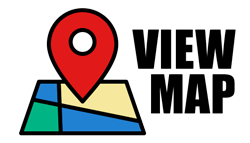







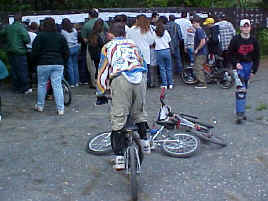
Social